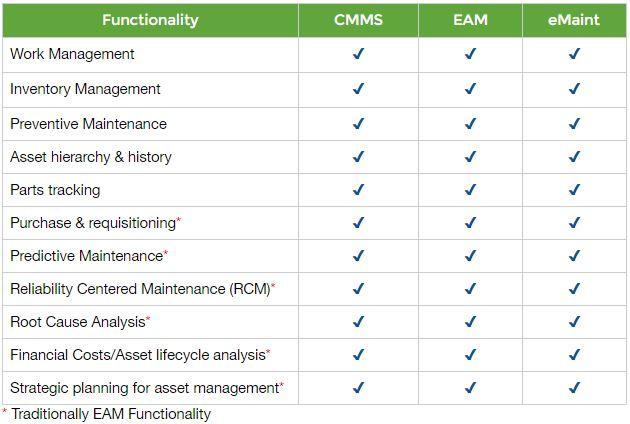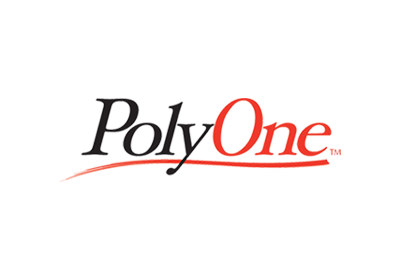What is a CMMS and EAM?
When searching for maintenance management systems, terms such as Computerized Maintenance Management Software (CMMS) and Enterprise Asset Management (EAM) are often used interchangeably.
CMMS software packages maintain electronic databases of data about the maintenance operations of an organization. CMMS is traditionally used to schedule and dispatch work, improve efficiency, help management make more information decisions, to support regulatory compliance, and more.
EAM is the optimal life cycle management of an organization’s physical assets. EAM includes aspects of business such as operations, maintenance and decommissioning/replacement of a plant, equipment and facilities, design, and more.
At one time, CMMS and EAM were seen as vastly different solutions for maintenance management. However, with the modern systems on the market today, the lines between the two have blurred. To help explain the primary differences between CMMS and EAM, let’s quickly rewind 30 years to the inception of CMMS and EAM, and then discuss how the differences have evolved from software functionality to a maintenance “state of mind.”
The History of CMMS & EAM
In the 1980s when CMMS systems were first introduced on the market by eMaint and other providers, they were working to replace manual maintenance systems and to develop:
- Work Order Management
- Spare Parts Inventory Management
- Preventive Maintenance Scheduling
- Asset Histories
On the heels of the technology boom of the 1990s, EAM software was developed, looking to offer a superset of CMMS features for enterprise organizations with global maintenance initiatives. Organizations began to see that maintenance was not just limited to one department, but required a 360 degree view. Traditionally, these systems included CMMS functionality as well as:
- Root Cause Analysis
- Predictive Maintenance
- Financial Costs/Asset lifecycle analysis
CMMS vs. EAM Today
The early 2000s saw the emergence of the Internet. During this time, as technology improved and best practices about asset health and governance shifted, the landscape demanded a change in software. CMMS providers such as eMaint rose to the challenge, and incorporated more robust reporting and analytical toolsto offer a more complete asset management solution. As a result, the distinction between CMMS and EAM dissipated for the most part. In today’s technological environment, Enterprise Asset Management is more of a business approach than a uniquely different software solution.
Today, maintenance plays a vital role within companies across all industries, and assets are considered corporate entities. With EAM as a maintenance ideology, CMMS is the method to successfully disseminate standards and global initiatives across an entire organization. Our eMaint solution is a CMMS & EAM and can deliver a wide range of functionality to facilitate maintenance success for small, midsize and enterprise clients that can be deployed quickly, with lower upfront costs than a traditional Enterprise strength system.

eMaint CMMS Enterprise Clients & Results
eMaint’s cloud-based maintenance management system is a modern solution that encompasses the agility necessary to offer global organizations the tools they need to better manage their maintenance operations, control costs and increase overall productivity. When you sign on with eMaint CMMS, you get the range of functionality you need, with the ability to expand your usage when you want.

After a two-plant pilot, a standardised “global configuration” was developed. PolyOne’s Reliability Program (PRP) was rolled-out. The team set up a project timeline and included a week of PRP training, a site specific Lean Six Sigma/DMAIC PRP project, implementation of eMaint CMMS, along with a PdM program for the site. Since implementing eMaint, PolyOne:
- Completed rollout to 50 locations in just over one year – 12 months ahead of schedule.
- Reached targeted maintenance expense reductions in the first full year of operation, a large part due to global transparency of parts inventory.
- Allowed quantifiable assessment of maintenance reliability, both at the micro (asset/plant) and macro (regional/corporate) levels.
- Improved their proactive approach to maintenance, producing a wave of preventive maintenance initiatives.
- For PolyOne customers, the initiative has contributed to the company’s ongoing improvements in response time, reliability and quality.
- Won the 2014 Uptime Award for “Best Emerging Maintenance Reliability Program”
Herbalife, a global nutrition company, manufactures and sells nutrition, weight management, and skin-care products.
When the company opened a new facility and over 1,000 assets comes online, Herbalife sought a flexible system that included:
- Ultimate integration of the corporate finance and procurement systems
- Ability to meet QC software validation requirements
- Ability to satisfy live audits by US Food & Drug Administration (FDA) and NSF International
- Extensive training availability
- A product that enabled mobile device use
Herbalife experienced these benefits since implementing eMaint:
- Passed outside audit scrutiny by having the assets and planned inspections organized and ready for review when asked
- Spotted “opportunities” and accountability of completed work
- Leveraged the simplicity for PM Instruction duplication by taking Instruction improvement ideas and applying them across multiple assets
Working Together To Support Reliability: CMMS & EAM
To recap, the difference between CMMS and EAM used to represent the enhanced functionality of EAM for larger, enterprise organizations looking to standardize, manage financials, perform Root Cause Analysis and more. With technological advancements and as best practices concerning maintenance evolved, innovative CMMS providers expanded the functionality of their software, effectively blurring the lines between CMMS and EAM.
As corporations come to understand and identify the importance of maintenance on a global scale, Enterprise Asset Management has become more of a corporate approach or business philosophy, while CMMS helps organizations realize asset management on an Enterprise scale.
Interested in learning more about how eMaint CMMS can help you achieve you goals? Attend a Live Product Demo.

